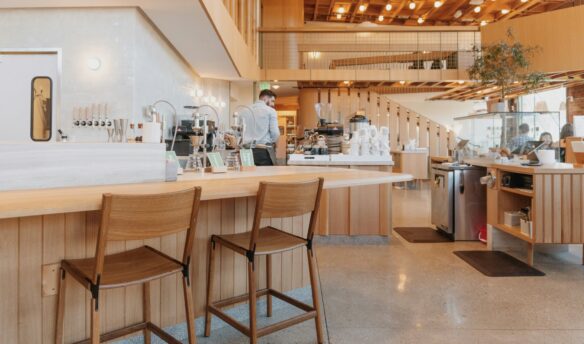How many pounds are in a kilogram? The commodity coffee market goes metric. Plus, Colombia pays farmers to switch from growing coca to coffee, and a new study on coffee and aging shows coffee is good for you — and gets the New York Times press bump.
‘The “C Price” as the Coffee Industry Knows It is Being Phased Out’ – via Daily Coffee News
Although many specialty coffee buyers don’t use the arabica coffee futures market to determine pricing, it remains an important benchmark. Known as the “C price,” the arabica market price for coffee changes daily and serves as a snapshot of the industry’s performance.
The C price has been all over the place over the last few years, illustrating just how volatile the coffee market is. Earlier this year, the C market price climbed to above $4 per pound, a historic milestone heralded as “a new era” for coffee. Five years ago, it dropped below $1 per pound, triggering the Specialty Coffee Association to label the event a pricing crisis.
The C market has always been complex, but the price changes are easy to understand because they’re shown in dollars (or cents) per pound—a familiar and straightforward measurement for many. But going forward, that’s all about to change.
As Nick Brown reports for Daily Coffee News, the company that runs the C market, the Intercontinental Exchange (ICE), announced that it is phasing out the current U.S. cents-per-pound benchmark. They’re replacing the C market price with dollars per metric ton.
The C market price determines coffee futures, or contracts where buyers and sellers agree to trade coffee at a set price in the future. March 2028 will be the last month for contracts using the old system, according to a press release from ICE. The exchange will introduce new contracts using metric tons later this year.
Commodities consultant Judith Ganes told Brown that she was surprised the move hadn’t happened earlier. The new pricing system aligns with how robusta futures are traded, Ganes said, and “takes into consideration big bags now, and bulk shipping. Price-by-the-pound was becoming more obsolete.”
Read the full story on the changing C price here.
‘Aiming a Blow at Narcos, Colombia Pays Farmers to Uproot Coca’ – via France 24
Not for the first time, the Colombian government is trying to convince farmers to replace their coca crops with alternatives like coffee. The move comes as the country’s leftist president, Gustavo Petro, attempts a more conciliatory approach to the illicit drug trade. Many parts of Colombia are dominated by armed groups who often force rural communities to clear forests in order to grow coca, the raw material for cocaine.
As David Salazar reports for AFP News, the government is paying 4,000 families in three regions to dig up their coca plants. However, many participants in the program aren’t seeing the expected results. One farmer, Nicolas Caicedo, told AFP News that his guaranteed income from coca was $800 a month—the government’s first payment was just $300, although they promised more to come.
Another anonymous farmer expressed doubt about the project’s success, noting that armed groups control the area. “No armed group that lives off (coca) is going to want a farmer to stop growing coca and switch to coffee,” he said.
The United States has been in a decades-long war on drug use domestically. Despite attempted clampdowns on drug use, these efforts to reduce drug use in the U.S. have not stamped out illicit cocaine production in Colombia. President Petro is trying a different approach, negotiating with armed groups and mulling the idea of decriminalizing cocaine. He has also called on the United Nations to remove the coca leaf from its list of dangerous drugs.
Replacing coca farming with coffee has been tried before. In 2015, during negotiations with the guerrilla group FARC, the government proposed a similar plan, which involved farmers voluntarily replacing coca with legal crops and the government making social investments in impoverished coca-growing regions.
Despite its use as the base of cocaine, coca also plays an important cultural and religious role among some indigenous Andean communities. One group in Colombia’s Cauca region has begun experimenting with using the coca plant to create alternative products such as fertilizers.
Read the full story on Colombia’s efforts to replace coca with coffee here.
More News
‘Australian Growers Aim for ‘Specialty Coffee’ Status As Price of International Beans Rises’ – via ABC News Australia
‘Oregon Coffee Leaders Speak Up Over Tariffs, Funding Cuts and Political Inaction’ – via Daily Coffee News
‘Brazil’s New Coffee Crop Drive Prices to Multi-Month Lows’ – via Comunicaffe
‘Wayne Gretzky (The Coffee Drink) Is Not A Great One’ – via Sprudge
‘Indonesian Jailed for Bali Bombing Starts Coffee Business’ – via Reuters
‘Bulletproof Rebrands Without Focusing on Mold and Toxicity’ – via Daily Coffee News
The Week in Coffee Unionizing
- Workers at a Starbucks in Albuquerque, New Mexico, voted to unionize last week, becoming the 600th U.S. store to join Starbucks Workers United. “Tonight’s milestone proves what’s been obvious to us – Starbucks partners aren’t just ready for change, they’re ready to organize and fight for it,” the union wrote on Bluesky. Workers at locations in Pennsylvania, Kentucky, and two in Virginia also unionized last week.
- After unionizing in April, workers at Anodyne Coffee Roasting Co. in Milwaukee, Wisconsin, voted in favor of joining the Milwaukee Area Service and Hospitality Workers Organization (MASH). The union had requested voluntary recognition from Fairwave, the private equity-backed holding company that has bought up numerous specialty coffee companies over the past few years. Management denied their request for voluntary recognition, so the National Labor Relations Board arranged a vote. MASH said not a single worker voted against unionization.
- Workers at a Starbucks location in Victoria, British Columbia, have also unionized. Organizers reached the threshold for automatic union certification—for new unions in B.C., that threshold is 45% of a store’s workers—in less than a week. “We did have a lot of pro-union sentiment in the store before we started, so finding the numbers wasn’t very difficult,” said shift supervisor Syssillia Reid. The workers now need to wait for final approval from the B.C. Labor Relations Board, allowing them to join United Steelworkers.
Is Coffee Good For You?
Drinking coffee during middle age could have a beneficial effect on the aging process. A new study from Harvard University analyzed dietary data from a 30-year study of more than 47,000 female nurses and found that moderate coffee drinking into middle age was linked to better health outcomes.
As reported by Alice Callahan for the New York Times, the study involved detailed dietary questions recorded every few years since the 1970s. The researchers then investigated the health outcomes of those who were still living and found a correlation between individuals who had met the researcher’s criteria for healthy aging and those who drank coffee between the ages of 45 and 60.
The study defined “healthy aging” as reaching age 70 without developing one of 11 chronic diseases and having no cognitive, mental health, or memory impairment while maintaining good physical function.
Other drinks, such as tea and decaf coffee, did not show the same correlation, while soda was associated with “significantly decreased odds of healthy aging,” Callahan reported.
It’s worth noting that the research was presented at the annual meeting of the American Society for Nutrition in Orlando, Florida. As Callahan notes, the study hasn’t been published or peer-reviewed.
It’s also worth noting just how well-covered this not-quite study has been: In addition to The New York Times, the research was covered by CNN, Time, Fox News, People, Sky News, The New York Post, Newsweek, Today.com, and many others.
Beyond the Headlines
‘Who Benefits From Coffee’s Enduring Newsworthiness?’ by Fionn Pooler
‘Experts Share Emerging Coffee Industry Trends of 2025’ by Garrett Oden
















